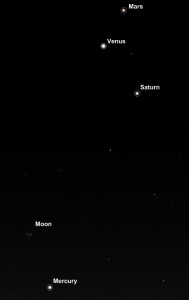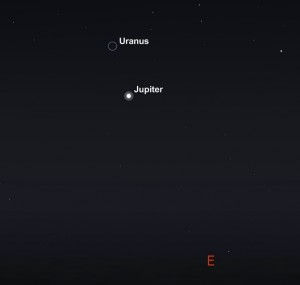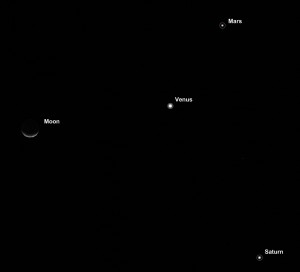These notes are intended to provide a casual skywatcher or someone already into amateur astronomy living in the Australian Capital Territory or in South East Queensland (Brisbane, the Gold Coast and the Sunshine Coast) with a short summary of what is happening in the night sky this week. Most of the information and finder charts will also be useful for observers elsewhere in Eastern Australia. Finally, instructions on how to obtain customised satellite viewing information for your location can be found here.
If you find this page of interest, you may wish to follow this website automatically using Twitter and the sites RSS Feed.
Predictable Sky and Space Events
All week
The planets Mercury, Venus, Mars and Saturn are easily visible to the unaided eye in the evening twilight and early evening sky all week. The below chart is for Thursday 12 August 2010 near the end of evening twilight but is useful for the whole week to show where the four planets are located in the early evening sky. A similiar gathering (where these four planets plus the Earth’s Moon will be within 18.5 degrees of each other) won’t be visible until September 2040.

If you are new to astronomy, one of the first questions you are likely to ask at the moment is “What is that bright flickering star I can see above the Western horizon in the early evening sky?”. That is Venus. The reason for it flickering has to do with the light from it being ‘bent’ or broken into the individual colours of the rainbow/spectrum by the Earth’s atmosphere as it starts to set. The lower down an object is the more atmosphere the light has to travel through. Add in a bit of wind in the upper atmosphere and you start to get a ‘star’ which can change colour and make people wonder if they are seeing a UFO. They aren’t. It is just Venus.
Jupiter can easily visible as a bright star above the Eastern horizon from around 9.30 pm onwards. With binoculars (at least 10 by 50’s), and a bit of patience you will be able to locate the planet Uranus. In spite of it’s significant size, Uranus is not very impressive – even in a large amateur telescope. It is just too far away.
Sunday 8 August 2010
Mercury at aphelion
Monday 9 August 2010
Look around 9.30 pm all week above the Eastern horizon to locate Jupiter. It appears to the unaided eye as a very bright star. If you have patience and a better finder chart, you can also find the planet Uranus with only a pair of binoculars. It will take a telescope however to resolve Uranus’s disc.

Tuesday 10 August 2010
New Moon
Wednesday 11 August 2010
Moon at perigee (4am AEST)
Thursday 12 August 2010
Perseids Meteor Shower Peak. This gets a lot of media attention given that it occurs during the Northern hemisphere Summer when it can easily be observed. From most of Australia, the radiant (the point from which meteors appear to come from) is below our local horizon and therefore we miss out on most of the meteors.
If you want to find out more about the Perseid Meteor Shower from a Northern hemisphere perspective, NASA Science News has an interesting story about it here.
Friday 13 August 2010
Moon located 8 degrees North of Saturn (5pm)
Moon located 5 degrees North of the Venus (10pm)

Saturday 14 August 2010
Moon 6 degrees North of Mars
For Further Information
Planet and Moon Rise/Set Times
Planet and Moon rise/set times for 2010 can be found here on this website.
Customised Astronomy & Satellite Viewing information
Information on how to obtain customised astronomy & satellite viewing information for your location can be found here on this website.
Great Red Spot (Jupiter) viewing times
Information on when to see the Great Red Spot on Jupiter in 2010 can be found here on this website. Keep in mind that Jupiter is currently only visible in the morning sky.
sorry on the 15th of August are not 7 planets going to be visable in the western sky??? or am i mistaken and should not go and lend a telescope? please answer